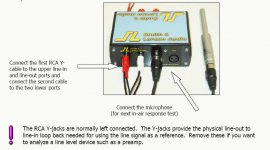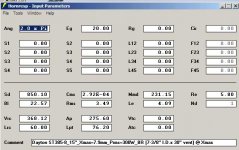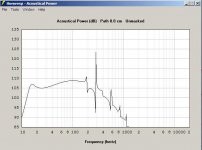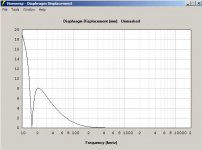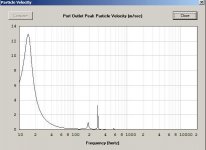Come to think of it, in this case, what we really need is a copy of the samples in the controller, right?
What would be TOTALLY AWESOME right now would be a .wav file recorded with a wire going from the sample box thing into a pc / digital recorder while the organist plays each note in progression, at full volume, and then perhaps a couple of songs with harmonic structure.
Edit: I mean, that would be my step 1 if I were on location and asked to design an enclosure to cover it.
What would be TOTALLY AWESOME right now would be a .wav file recorded with a wire going from the sample box thing into a pc / digital recorder while the organist plays each note in progression, at full volume, and then perhaps a couple of songs with harmonic structure.
Edit: I mean, that would be my step 1 if I were on location and asked to design an enclosure to cover it.
Last edited:
Last edited:
Ones with dual 18 inch drivers and 20 Kw of input power.
Stop it, it's too early in the morning to be having impure thoughts.
The only thought I had when testing that beast was please stop!
It was most uncomfortable.
And that was with foam earplugs and aircraft grade hearing protectors.
It was most uncomfortable.
And that was with foam earplugs and aircraft grade hearing protectors.
The only thought I had when testing that beast was please stop!
It was most uncomfortable.
And that was with foam earplugs and aircraft grade hearing protectors.
I bet! My weakness for hugely powerful subwoofers is mostly just how clean and effortless they can be at reasonable levels, though.
I do have my moments when I want to feel my hair puffing against my scalp, but for the most part, single digit distortion figures in the ~110 - 115db range is far more entertaining.
single digit distortion figures in the ~110 - 115db range is far more entertaining
For that sir you need either a whole bunch of drivers or a horn. (But you knew that)
For that sir you need either a whole bunch of drivers or a horn. (But you knew that)
Yeah, I'm still pissed that the basement flood I had last year killed my tapped horns. I plan on remaking some at some point.
No, it doesn't, and it isn't. What you are looking at is not the "bandwidth" of the signal, but the width of the sampling filter in the spectrum analyzer . . . the workings of which you don't understand any better than you understand organs or acoustics (which is, in turn, far far less than you imagine that you do).
You could have just asked for a much higher resolution sample instead of claiming I don't know what I'm looking at. This program is capable of very high resolution, you can look at a much narrower bandwidth. There's nothing wrong with the program, you can look at frequency and amplitude vs time.
You guys think it's ok to rely on that graph to prove that the 16 hz note is way down in amplitude from the higher notes but not ok to determine the bandwidth of the notes even though you know nothing of the musical piece being played (was the 16 hz note supposed to be at full volume?), you don't know anything about the organ it was played on (is it a good example of an organ with a 16 hz pipe?) you don't know anything about the building it's in (is it sucking the life out of the 16 hz note?) and you don't know how that applies to any other pipe organ in the world (are other pipe organs more capable?), (are other pipe organs with speakers going to boost the 16 hz signal so it's audible?). This last is entirely possible especially in cases like the OP's and it could cause a MAJOR problem with excursion.
No, it isn't and you didn't. Repeatedly saying that you've done something which you haven't doesn't make it so that you did. All it does is further demonstrate that "know it all" and "idiot" are often synonyms . . .
Idiot now. Nice. Might I point out that although presenting absolutely no technical information whatsoever you are claiming to "know it all" just as much as I am? I suppose you think the synonym doesn't apply in your case.
FFT analysis of a dynamically changing signal, like music, gives just rough estimate. Theoretically it is invalid.
You can change the sampling time too. You can get very high resolution to 1 second or probably less (it's been awhile since I checked). There isn't too much dynamic change in a signal less than 1 second, especially for an instrument known for it's long and sustained notes.
There's one fact. A simulation program will not hear port compression.
A discerning listener will.
If you have the hearing acuity to tune an instrument you will hear these effects of box and port resonances, and port compression.
I know this because I hear all these effects.
And quite a few people that I have worked with do to. Ones that work in audio daily and ones that are simply acute listeners.
I'M the one promoting the simulators and I'M the one that brought up port compression.
Of course you can't see it in a sim, that's why I account for it and mention it often.
You can't hear it until it's a major problem. At some point everyone is going to be able to hear it, but not until it's a huge problem. A 1 - 2 db loss over a very narrow bandwidth is hardly audible even when you know exactly what you are listening for.
Distortion masks clarity of reproduction. In the intended use of this thread getting the sound as clean as possible means you will hear more of the organ sound and less of the drivers sound.
...
A simple rule of thumb in bass reproduction is that below 10% distortion people don't usually notice it.
Yes, distortion has been mentioned in passing and I talk about and link Ricci's measurement all the time. I even posted one of his measurements in this thread.
Distortion is a problem, that's what klippel testing is for, and that's why we (should) keep things under xmax. If you follow the klippel rated xmax rating you won't go above 20 percent distortion (which is a common klippel spec for subs). If you want to stay within 10 percent you have to back off the volume even more than the klippel rated xmax would suggest.
And these are not SIMS!
These are actual functioning systems.
OMG, there's nothing wrong with sims. They are an incredibly useful tool. Those of you that don't think so either haven't used them or don't know how to use them properly.
They are not perfect but their limitations can be easily accounted for.
You guys realize that basically everything is simulated these days, right? From the passenger jets and cars you trust your lives with all the way down to the simpler things in life, simulation is a tool that the whole world uses to great effect. I'm not talking about flight simulators to teach people to fly either, I'm talking about full systems analysis, parts manufacture, simulating prototypes in flight, and every other aspect.
You can't hear it until it's a major problem. At some point everyone is going to be able to hear it, but not until it's a huge problem. A 1 - 2 db loss over a very narrow bandwidth is hardly audible even when you know exactly what you are listening for.
I take one part of your post here and address it.
As you go lower down in frequency our ears have a threshold of where we can discern any given tone. Above that threshold and especially near and below 16 hertz even a one db difference is perceived as quite a difference in apparent amplitude.
http://www.noiseandhealth.org/artic...me=6;issue=23;spage=37;epage=57;aulast=Moller
And at this point I'm going to officially give up (not as a response to Mark's last post, but just as a general response to this thread). You guys posted 2 pages of stuff in a couple of hours while I was sleeping. I can't keep up. You guys can go a lot faster because you are not posting any technical info or even trying. Clearly not reading what I'm posting either, so that saves a lot of time for you.
I put a good bit of effort into this, posted sims, graphs, pictures, outside quotes, links, and a whole boatload of tech info and common sense. Nobody else is even trying, especially the organ guys.
If it was just Deward or just Ben or just Mark I could school you guys one at a time, but I can't keep up if you are going to gang up on me, and there isn't any point. You guys are so stuck in your errors and points of view that nothing is going to change. And in Deward's case at least, it's clear he's NEVER going to quit. Despite being proved wrong on almost every single thing he's said, he just keeps coming back, with no technical info at all, only a constant barrage of personal insults (also not uncommon for Mark and Ben). And I really don't mind the insults, what I don't care for is the decidedly untechnical conversation and the absolute and complete inability to admit when they are wrong. (I can and have, at least a couple times in the last month alone.)
So I'm officially out, you guys can feed each other's delusions without any interruption from me, reality or science now. I think it's pretty safe to assume I'm not going to agree with ANYTHING Ben or Deward say, and only about half of what Mark says, so you can assume I would have replied as such if I were to continue replying. Do not take my silence as any type of statement that I agree with any of the nonsense and errors you continue to post.
Have a good time guys.
Good luck OP. You are going to need it. There's a couple guys in this thread that know what they are talking about but they don't post much. The "organ" guys don't have a clue what they are talking about and they will lead you astray, overshoot your budget, not address your original problem and make a mess of your system if you follow their advice.
I put a good bit of effort into this, posted sims, graphs, pictures, outside quotes, links, and a whole boatload of tech info and common sense. Nobody else is even trying, especially the organ guys.
If it was just Deward or just Ben or just Mark I could school you guys one at a time, but I can't keep up if you are going to gang up on me, and there isn't any point. You guys are so stuck in your errors and points of view that nothing is going to change. And in Deward's case at least, it's clear he's NEVER going to quit. Despite being proved wrong on almost every single thing he's said, he just keeps coming back, with no technical info at all, only a constant barrage of personal insults (also not uncommon for Mark and Ben). And I really don't mind the insults, what I don't care for is the decidedly untechnical conversation and the absolute and complete inability to admit when they are wrong. (I can and have, at least a couple times in the last month alone.)
So I'm officially out, you guys can feed each other's delusions without any interruption from me, reality or science now. I think it's pretty safe to assume I'm not going to agree with ANYTHING Ben or Deward say, and only about half of what Mark says, so you can assume I would have replied as such if I were to continue replying. Do not take my silence as any type of statement that I agree with any of the nonsense and errors you continue to post.
Have a good time guys.
Good luck OP. You are going to need it. There's a couple guys in this thread that know what they are talking about but they don't post much. The "organ" guys don't have a clue what they are talking about and they will lead you astray, overshoot your budget, not address your original problem and make a mess of your system if you follow their advice.
Last edited:
I went to Lowe's yesterday. Did locate some Sonotube. BUT they had no 6 inch diameter tubes. The weird thing was that they had several tubes described as 8 inch nominal. I noticed that some of these would fit inside one another. So diameter really seems to be nominal in those things. I bought the smallest I could find, which measured 7 3/8 interior diameter.
So, can I use a 7 and 3/8 interior pipe? Or do I try to split it down the sides and reform it to come up with a 6 inch pipe? I'm guessing that a larger pipe diameter would need less length. But how long?
Any sage words of wisdom will be appreciated.
Too, the cubic feet in my box has been misstated here a few times. My measurements (after estimating for speaker and interior supports) come in at 13 cubic feet.
Some have posted SIMS that used 10 cu. ft. or some other number. So the suggested lengths might not be accurate. Could I yet again request confirmation?
I am going to start by putting the port in the box with the existing 15 inch Dayton Driver. I'll do some testing and see what happens. Bought some new testing toys. I'll try to measure before and after.
And yes, I'll report back.
I'm not going to select a classroom monitor, but you guys try to play nice while I'm gone. 😉
Bach On
So, can I use a 7 and 3/8 interior pipe? Or do I try to split it down the sides and reform it to come up with a 6 inch pipe? I'm guessing that a larger pipe diameter would need less length. But how long?
Any sage words of wisdom will be appreciated.
Too, the cubic feet in my box has been misstated here a few times. My measurements (after estimating for speaker and interior supports) come in at 13 cubic feet.
Some have posted SIMS that used 10 cu. ft. or some other number. So the suggested lengths might not be accurate. Could I yet again request confirmation?
I am going to start by putting the port in the box with the existing 15 inch Dayton Driver. I'll do some testing and see what happens. Bought some new testing toys. I'll try to measure before and after.
And yes, I'll report back.
I'm not going to select a classroom monitor, but you guys try to play nice while I'm gone. 😉
Bach On
Thanks, JAG. I always hope for good luck. But I don't count on it to pay the bills.
Some of the best lessons I've learned in my life came from unpleasant situations. My Dad used to call that "getting an education at Hard Knocks University".
Good luck to you!
Bach On
Some of the best lessons I've learned in my life came from unpleasant situations. My Dad used to call that "getting an education at Hard Knocks University".
Good luck to you!
Bach On
I went to Lowe's yesterday. Did locate some Sonotube. BUT they had no 6 inch diameter tubes. The weird thing was that they had several tubes described as 8 inch nominal. I noticed that some of these would fit inside one another. So diameter really seems to be nominal in those things. I bought the smallest I could find, which measured 7 3/8 interior diameter.
So, can I use a 7 and 3/8 interior pipe? Or do I try to split it down the sides and reform it to come up with a 6 inch pipe? I'm guessing that a larger pipe diameter would need less length. But how long?
Any sage words of wisdom will be appreciated.
Too, the cubic feet in my box has been misstated here a few times. My measurements (after estimating for speaker and interior supports) come in at 13 cubic feet.
Some have posted SIMS that used 10 cu. ft. or some other number. So the suggested lengths might not be accurate. Could I yet again request confirmation?
I am going to start by putting the port in the box with the existing 15 inch Dayton Driver. I'll do some testing and see what happens. Bought some new testing toys. I'll try to measure before and after.
And yes, I'll report back.
I'm not going to select a classroom monitor, but you guys try to play nice while I'm gone. 😉
Bach On
For 7 3/8", assuming 13 cubic feet, you're looking at around 28.5" of length for 16 hz tune.
If it is indeed 10 cubic feet, then the length should change to 38.72". As you can tell, it's pretty critical that we get the volume nearly spot on.
Hi Bach On,
Post #431: "...bought the smallest I could find, which measured 7 3/8 interior diameter...My measurements (after estimating for speaker and interior supports) come in at 13 cubic feet."
First, the bigger the I.D. the longer the port must be for a given enclosure resonance.
Also, I'm adding the screenprints for your BR w/ Vrc=13ft^3(368.12L) and a 7-38"I.D x 30"long vent.
If possible I would add the duct in the bottom, and elevate the box about 3", e.g.: little 2x4 squares at the corners.
Regards,
Post #431: "...bought the smallest I could find, which measured 7 3/8 interior diameter...My measurements (after estimating for speaker and interior supports) come in at 13 cubic feet."
First, the bigger the I.D. the longer the port must be for a given enclosure resonance.
Also, I'm adding the screenprints for your BR w/ Vrc=13ft^3(368.12L) and a 7-38"I.D x 30"long vent.
If possible I would add the duct in the bottom, and elevate the box about 3", e.g.: little 2x4 squares at the corners.
Regards,
Attachments
Too, the cubic feet in my box has been misstated here a few times. My measurements (after estimating for speaker and interior supports) come in at 13 cubic feet.
Some have posted SIMS that used 10 cu. ft. or some other number. So the suggested lengths might not be accurate. Could I yet again request confirmation?
I much as I would desperately love to be done with this thread, you asked nicely so -
My sims came out to 380.1 liters or 13.43 cubic feet net including port volume (which assumes the port is inside the box). That's internal, not including the wood or space taken up by the driver. The volume is reported right on the schematic picture and the last time I posted the sim was post 339 if you want to take a look. http://www.diyaudio.com/forums/subwoofers/272833-16-hz-church-organ-34.html#post4301004
I believe I did mention 10 cubic feet a couple times, that was just an offhand guess without going to look at the schematic, sorry for the confusion.
BUT use TB46's sim, not mine. He can confirm his sim dimensions for you. His design used a standard 6 inch diameter port, mine was larger and probably won't conform to any diameter you can actually buy. And make sure to put the port exactly where he said it should go, he did an advanced mltl sim to find the proper place for it to reduce the effect of higher harmonic resonances.
Don't cut up the tube. Use it as it is and have the sim redone or get the proper diameter.
TB46 should be able to take it from here but if you have any questions for me PM me, I don't want to respond to this thread anymore.
EDIT - TB responded while I was typing. You are in good hands, he knows what he is doing.
Last edited:
The bigger the ID the shorter must be the tube, IIRC. Please correct me if I am wrong. It is time to dig up my vented enclosure calculator...First, the bigger the I.D. the longer the port must be for a given enclosure resonance.
Hi Bach On,
Post #431: "...bought the smallest I could find, which measured 7 3/8 interior diameter...My measurements (after estimating for speaker and interior supports) come in at 13 cubic feet."
First, the bigger the I.D. the longer the port must be for a given enclosure resonance.
Also, I'm adding the screenprints for your BR w/ Vrc=13ft^3(368.12L) and a 7-38"I.D x 30"long vent.
If possible I would add the duct in the bottom, and elevate the box about 3", e.g.: little 2x4 squares at the corners.
Regards,
Yes, you'd previously suggested putting a 6 inch port about a 1/3 down from the driver In a box with a front-to rear internal dimension of 23.5 - a 30 inch port won't fit unless part of it is hanging out the front - which I would rather not do.
So putting the port opening on bottom, but providing 3 inches of clearance between the bottom and the floor is the new recommendation with the bigger and longer port.
I'll go on and ask - is there a reason the port opening cannot be in the top - where clearance wouldn't be an issue?
BO
I'm driving so this may or may not make sense.the port needs to be attached to the box. it may be partially inside partially outside or wholly inside or outside. whatever makes the most sense is the best thing to do.
Crazy little dictation thing is working! who says technology is never good. just haven't figured out how to put a capital at the beginning of a sentence.
Crazy little dictation thing is working! who says technology is never good. just haven't figured out how to put a capital at the beginning of a sentence.
- Status
- Not open for further replies.
- Home
- Loudspeakers
- Subwoofers
- 16Hz for church organ
